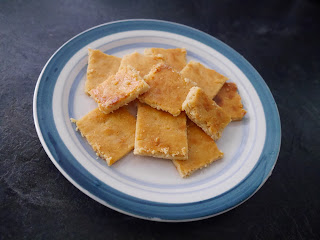গুড়ের সন্দেশ
Goorer Shondesh
Shondesh has been such a staple in my life. During my childhood in Dhaka, Nani would provide a steady supply from her favourite sweet shop in Meherpur, couriered over on a semi-regular basis. If it wasn't her, it would be my dad or uncle bringing some back from their trips to the countryside. Unfailingly, each would point out that shondesh made in their hometown was the best. Shondesh keeps well in the fridge, so even after a week we'd be digging some out to have with tea. As a voracious and indiscriminate eater, shondesh was just another sweet I stuffed myself with, but I do remember it being a favourite of my brother's - the picky eater in the family.
Shondesh comes in a few different forms, but basically it's yet another curd-based Bangladeshi dessert. If you're unfamiliar, imagine something a little like halwa, but softer and creamier. Making it involves sweetening and cooking curd on the hub, an easier process than cooking roshogolla or golap jaam. There are slight variations: you can sweeten the curd using sugar or goor, and you can opt to use spices or not. I prefer a version very lightly spiced with cardamom and sweetened with goor. The bones of this recipe comes from a friend's mom, who recommended that I just mix all the ingredients together before popping them into the oven. She served me a version of this one Eid, and I loved it, so I've now adopted her recipe.
The egg listed in the ingredients below is very non-traditional - the result of her experimentation with texture and consistency. I've kept it in because I quite like the resulting squidginess. Baking gives the top of the shondesh a slight caramelisation, in case you're into that kind of thing (I am). Make this in the right dish and you can serve it as is, rather than chopping it up into smaller pieces (which is traditional). Shondesh can be eaten as a dessert after a larger meal, but more usually in my family it was reserved for tea time snacking.
The egg listed in the ingredients below is very non-traditional - the result of her experimentation with texture and consistency. I've kept it in because I quite like the resulting squidginess. Baking gives the top of the shondesh a slight caramelisation, in case you're into that kind of thing (I am). Make this in the right dish and you can serve it as is, rather than chopping it up into smaller pieces (which is traditional). Shondesh can be eaten as a dessert after a larger meal, but more usually in my family it was reserved for tea time snacking.
Ingredients:
- 1.20 litres of milk
- 6.00 cardamoms
- 3.00 lemons, juiced
- 140.00 g goor (aka jaggery)
- 2.00 eggs
Method:
- Pour 1.00 litre of the milk in a saucepan, and add the cardamoms. Bring to boil
- As the milk is boiling, add the lemon juice and allow to curdle
- Once the curdling reaction is complete, take off the heat and strain the liquid away using a sieve
- Transfer back to the saucepan, and add cold water. Stir to "wash" the curd - this is to rid it of any residual lemon juice which may give the end product a lemon-y taste
- Once washed, strain the curd again through a sieve, but this time leave for at least an hour for it to dry out
- Heat the remaining 200.00 ml of milk and 140.00 g of goor in a milk pan, until the goor dissolves.
- Preheat the oven to 180 degrees Celsius and line an ovenproof dish with kitchen foil
 |
| The curd, milk, goor and egg mixture ready to bake |
- Beat the two eggs, and fold them as well as the milk mixture into the curd. Transfer to the ovenproof dish
- Bake for 30 minutes, until the top is golden
- Once out of the oven, leave until cool enough to handle, then pop out of the dish using the foil
- Cut into small squares, then serve warm or cold as desired
Additional info:
The goor can be swapped for sugar by weight, and will result in a lighter, milkier flavour. If you're planning to use sugar make sure there is no residual lemon in the curd, as it'll throw the flavour off. The egg, of course, can be omitted. Shondesh can also be cooked on the stove, but it's not something I've attempted personally.

No comments:
Post a Comment